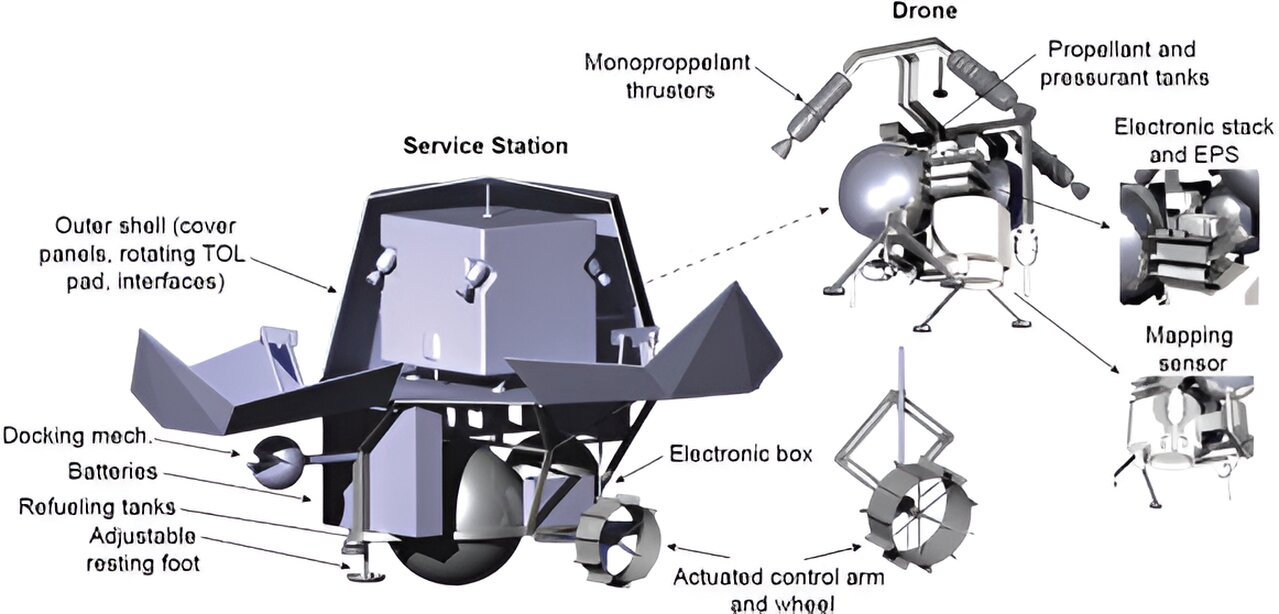Engineers and scientists strive to create a new concept for exploring the Moon using drones. The vehicles will both move on the surface and fly with the help of jet engines. This will help to better plan future missions.

Limitations of modern Moon mapping
The exploration of the Moon has been attracting more and more attention lately, especially after a number of landers have recently been launched with varying degrees of success. One of the challenges faced by these landers and any future manned missions is understanding the terrain they land on and potentially cross.
To solve this issue, a team of researchers from Switzerland has developed the concept of a drone that can help map some of the most interesting, potentially dangerous areas for exploring the moon of our planet.
Mapping the Moon has been a priority for many years. However, some of the most interesting regions, such as the Permanently Shadows Regions (PSR) at the Moon’s poles, which contain significant amounts of water ice, have only been mapped with a resolution of about 1 m per pixel in the best images. This is taking into account artificial improvement using algorithms with artificial intelligence.
This level of resolution is not enough to obtain useful data for planning any potential lunar rovers or manned missions — the wheel of a vehicle cannot even have that width, let alone hope to overcome an obstacle of that size.
Therefore, any lunar rover that we send must be manually controlled or move very slowly and autonomously. Given the limited operational timelines of the expected rover missions, such a slow pace may limit their ability to search for valuable resources and objects that scientists believe lurk in regions of constant shadow.
Attracting auxiliary drones
The obvious solution to this problem is to use another robot as a scout, similar to how Ingenuity did for the Perseverance rover on Mars until recently. This collaboration allowed Perseverance to set the record for the longest one-day autonomous journey on another planet — about 700 m. If the scout could map the details of the lunar surface in front of a potential rover, it could move even faster than Perseverance.
Larger systems may contain proven, off-the-shelf chemical engines that, after flight testing, can be bulky and use potentially dangerous chemicals. Smaller systems can use various forms of chemical engines, such as H2O2 rocket engines, or even more mundane means of transportation, for example, literally pushing off the ground with their legs. However, many technologies for this type of movement have not yet reached a high enough level of development to be used in practical missions.
Finding a middle ground between the old, heavier model of the lunar rover and the new, untested model was one of the main limitations when developing a new concept. The solution was a drone that would launch from the base station and return to it. The station could be towed by a lunar rover or another lunar exploration vehicle.
What is the new idea?
The base station would refuel the drone after each flight, which would allow it to make several flights without excess fuel weight. Under such conditions, the system can map up to 9 square kilometers of the Moon’s surface with a resolution that would be useful for planning both lunar rover and human missions. After completion, the base station will need to be refueled so that it can continue its mission, which is a central part of the project concept.
This idea has other advantages: many spacecraft should land on the ground, and their power plants can cause significant havoc in the lunar environment. This is especially undesirable if the surface they are landing on contains commercially viable materials such as water ice. Landing on a mobile docking station also eliminates any dust kick-up, which can make it much more difficult to work in a certain area, given the time of dust settling on the Moon.
Although there are some details in the document, including a discussion of high-level architecture using space-proven equipment, this idea remains only a concept. However, given the imminent approach of the date of man’s landing on the moon, NASA and other space agencies will undoubtedly benefit from a successful reconnaissance mission. But whether they will push this idea to the finish line remains to be seen.
According to phys.org
Follow us on Twitter to get the most interesting space news in time
https://twitter.comne/ust_magazine


